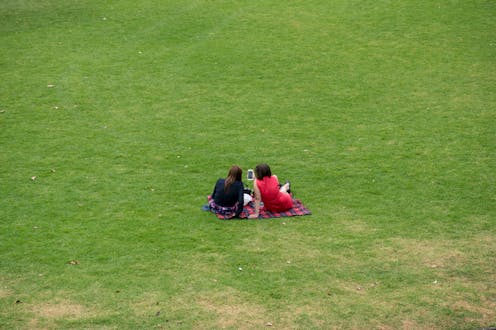Source: The Conversation (Au and NZ) – By Usha Manchanda Rodrigues, Professor, Deakin University

Shutterstock
News reporting on sexual and domestic violence ignores the multiple inequities faced by victims from culturally diverse backgrounds, and First Nations peoples.
A content analysis of stories published in three prominent Australian media found only a handful of stories mentioned “intersectional” factors such as race, class, caste, sexuality, age and ability. These factors often make it harder for women from culturally and linguistically diverse backgrounds to seek support.
The analysis of 191 stories about people from culturally diverse backgrounds, published by The Age, the Herald Sun, and the ABC during the second COVID lockdown in September-December 2020, did not contextualise their reporting on domestic and sexual violence.
Except for a handful of stories, most media reported the crimes as isolated incidents of violence rather than a social problem.
The reporting often ignored important information such as victims’ status as new immigrants, their visa status restricting them to work in Australia, financial and social isolation, and cultural backgrounds.
One of the exceptions was an article by the ABC’s Herlyn Kaur, which noted many migrant women wanted to leave their violent marriages but were unaware of their rights. A growing number of migrant women are seeking help from women’s refuges, on average staying there for 46 nights, which is 14 nights more than non-culturally diverse women.
First Nations leaders and organisations working to prevent violence against women and children have noted the use of stereotypes, framing stories in a sensational way, and ignoring violence committed against Indigenous women.
First Nations women are five times more likely to experience physical violence and three times more likely to experience sexual violence than other Australian women, according to Our Watch.
Read more:
No public outrage, no vigils: Australia’s silence at violence against Indigenous women
Women from diverse backgrounds make up a significant proportion of the Australian population. Almost 28% of residents are born overseas, while 22% use a language other than English at home.
The recently launched National Plan to End Violence against Women and Children (2022-2032), emphasises a need for using an intersectional lens when supporting victim-survivors of domestic and sexual violence.
Greater diversity in media is also needed
Australian newsrooms lag behind. This research found that less than a third (32.82%) of the stories about domestic and sexual violence against culturally and linguistically diverse Australians were reported by a journalist from a non-Anglo-Celtic background. A little over 69% of the news stories were reported by a journalist from an Anglo-Celtic background, while more than 41% were written by a male reporter. Some stories were written by more than one journalist, while about 5% had no byline.
In Victoria, family violence–related crimes increased by 7.5% between October 2019 and September 2020, with more than 90,000 offenses recorded. But, the number of news reports on violence against women remained miniscule. In the study period, about 500 articles on domestic violence, sexual harassment and sexual violence were published by the three media outlets. Of these, 191 referred to a person or the issue of culturally and linguistically diverse background.
The context of domestic and sexual violence is important, because nearly a third of Australians believe women who do not leave their abusive partners are partly responsible for the continuation of domestic violence. Moreover, 42% agree it is common for sexual assault accusations to be used as a way of getting back at men.
Nuanced reporting of violence against women from culturally diverse backgrounds will sensitise the population to the complexity of the issue. It will also encourage governments to offer information, support and services that match the multitude of inequities they endure.
This research finds an overwhelming number of news reports do not mention any factors that may affect victims and victim-survivors of domestic and sexual violence. The research raises a question: would a better understanding of the culturally diverse backgrounds of the victims help a journalist to report the nuances of these factors that multiply the suffering of victims?
The findings argue that diversity among journalists employed by Australian newsrooms is yet another area that needs attention. Increasing diversity would mean news stories about violence against women from culturally and linguistically diverse backgrounds and First Nations are reported with an intersectional lens.
It is worth noting that overwhelmingly, Australian television news and current affairs programs are curated, framed and presented by journalists and commentators from an Anglo-Celtic background.
Some signs of progress
On a positive note, this research found that news reports came from a variety of sources. They include:
- violence against women experts, advocates, and representatives of organisations supporting victims (21.75%)
- the courts (20.85%)
- interviews with a significant number of neighbours, relatives, and eyewitnesses (19.03%).
This is a positive change from the past, when research found the dominant source of stories about violence against women was law enforcement personnel.
Additionally, about a quarter of the stories raised some of the legal constraints that stopped journalists from providing important details. These included victims and their families being able to speak about the crimes without the risk of prosecution.
News articles in each of the three media touched on the campaign #LetHerSpeak, which was launched in November 2018 to abolish gag laws in some states in Australia that apply to sexual assault victims.
![]()
This article is part of The Conversation’s Breaking the Cycle series, which is supported by a philanthropic grant from the Paul Ramsay Foundation.
– ref. Media ignore women’s diverse backgrounds when reporting on family violence: new research – https://theconversation.com/media-ignore-womens-diverse-backgrounds-when-reporting-on-family-violence-new-research-192853







